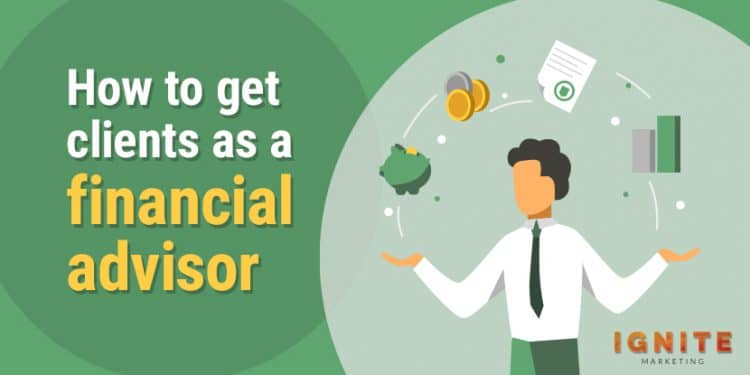


Growing a client base as a financial advisor can be frustrating ‒ especially if you're just starting.
The biggest obstacle you'll face is proving you know your stuff.
It's not easy to get people to trust you with their money ‒ you need a track record of financial success.
If you have a track record, finding clients should be relatively easy.
But if you don't, you'll need to get creative with your client acquisition strategies.
No matter where you're at in your journey as a financial advisor, the strategies contained in this article will help you attract new clients and grow your business.
Let's dive right in.
If you're a new advisor, it's going to be hard to turn strangers into clients. The most effective way to bring in new clients is to tap existing relationships and cultivate new ones.
If possible, build relationships with people who hold influence in financial matters. Accountants, business owners, and attorneys are all excellent examples.

Any business can run into financial trouble. Problems such as an inability to pay back owed debt and cash flow struggles can all contribute to the risk of business insolvency. While these types of people may not need your services themselves, a recommendation from someone with financial knowledge for small business restructure insolvency will hold far more weight than a recommendation from a hairdresser or florist.
That isn't to say you should ignore people who aren't trained in financial matters, though. There are more people with jobs outside of the finance sphere than there are inside of it. And these people may have their own business and are in need of financial services such as Company Debt Assessment. Look into insolvency practitioner fees if you're planning to seek insolvency and debt management solutions.
The higher volume of referrals you'll get by targeting people without finance experience can bring in just as many clients as the higher quality referrals you'll get from people who do understand finance.
Some advisors feel at home rubbing elbows with fellow professionals, while others get a bit nervous at the thought of all that talking. But no matter which side of the conversational spectrum you fall on, networking remains an essential part of a financial advisor's job.
If you want to network effectively and create positive relationships with as many influential people as possible, the following tips might be helpful.
The most important part of the networking process is the initial meeting. The first few minutes you spend with someone will determine how much they like you, so you must make a great first impression.

Many advisors prefer to wing their introductions and let the natural flow of the conversation guide what they say.
That works well enough if you're an experienced conversationalist. However, those who tend to flounder when meeting someone new would benefit from creating a short speech about who you are and what you do.
Be sure to include a basic description of the services you offer, how you've helped previous clients, and any other information that shows you're qualified to manage their money.
It's also essential that the speech sounds fresh and off-the-cuff when you deliver it. You don't want to look like you're repeating something you've rehearsed a million times. This will come off as robotic and will make potential clients feel uncomfortable.
You do need to rehearse it, though. The last thing you want is to forget what you're supposed to say halfway through the speech. Unless you can recover quickly, the sudden lack of talking will tip people off that you were using a script.
So practice until you've got it down pat. Practice as you're getting dressed in the morning and as you're commuting to work. Get feedback from friends and family to ensure your delivery of the speech sounds natural and genuine.
One more tip: hand over a business card at some point during the speech. If someone is interested in hiring you, they'll need to know how to contact you.
If the first speech goes well, the person you're talking to will start asking questions about your financial experience and philosophy. While this might be intimidating, it's a promising sign; someone who is asking questions is genuinely interested in what you have to offer.

When answering questions, try to give answers that are fresh and interesting. You're probably not the first financial advisor this person has talked to, so you don't want to rehash standard talking points that they're likely familiar with. Use your experience to provide a unique perspective on whatever they ask you about.
And although scripting your answers isn't always reliable, you should go into networking events with a feel for the questions people might ask. Here are a few of the more common questions you'll encounter:
As long as you have a sense of how to answer these questions, you should be good to go.
You're not networking with robots. These are humans you're talking to. These humans have emotions and interests and egos, and you need to remember that when you're out trying to land clients.
Don't make the conversation about you and your financial services. Your potential clients would much rather talk about themselves than hear you wax poetic about your business.
So let them talk. Ask them questions about who they are and what they do. Handing over the proverbial microphone will instantly make people like you more.
And don't worry; the conversation will eventually wind its way to you. When it does, you can make your sales pitch to someone who likes you a lot more than they did five minutes ago.
As is the case with most industries, your odds of converting potential clients into paying customers will increase significantly if you have a sleek, professional website.
A modern website is the digital equivalent of making a great first impression. If your site is poorly designed or slow, visitors will be less likely to hire you as their financial advisor.
Alright, let's get to it. Here are some essential elements of a great website that brings in traffic and generates conversions.
A complementary color scheme will make your site pleasing to the eye. To find a color scheme for your website, you can use this excellent AI-driven color scheme generation tool: Colormind.io
If your site doesn't load quickly, impatient people who might have otherwise become clients will close out of your website and never return.

A slow-loading website will also impact your search engine optimization (SEO). Search engines like Google and Bing want to direct searchers to sites that load within a reasonable timeframe. If your site is on the slower side, you're going to drop in the search rankings and get less traffic overall.
Fortunately, most site speed improvements are pretty easy to implement. Here are a few of the best ways to decrease load times.
For a full rundown of the technical changes you can make to improve your site speed, I recommend reading this comprehensive article from CrazyEgg: 20 Ways to Speed Up Your Website and Improve Conversion
The content on your website should be laid out in an F-pattern or a Z-pattern. These two layout options will increase conversions and make your site more comfortable to use.
More people browse the web with mobile devices than with computers. To accommodate these phone and tablet users, you need to make sure your website is responsive and changes its layout based on the screen size.
Your website should have a prominent menu with links to every relevant page on your site. You should also add internal links to other articles on your site when you're creating content.
Many potential clients will find your website by searching for something on Google or Bing. As long as your site is set up with conversions in mind, this organic traffic can become a lucrative and free source of clients.
Search engine users can't visit your site if you don't rank well in the search results, though. Use the following tips to boost your position in the search results and drive more traffic to your website.
If you've got some writing chops, starting a blog is an excellent way to drive traffic to your website and establish yourself as a thought leader in your industry.
There are a ton of things that go into creating a successful blog. I won't attempt to cover them all in this article. Instead, I encourage you to read through the following blog-related resources.
So, your blog has steady traffic coming, but now what?
It's pretty hard to turn a brand new website visitor into a paying client. If you bombard every visitor with "hire me now!" messages, you're not going to be happy with the resulting conversion rate.
To increase the number of clients you get from your website, you need a way to get their contact information. If you can convince visitors to give you an email address, you can nurture them toward becoming clients with educational and entertaining emails.

In the marketing world, someone who expresses interest in your service by giving you their contact information is called a lead.
You can't merely ask for an email address and expect to get it, though. Most people will want something valuable in return for their contact information.
This valuable item is called a lead magnet, and you'll need to make one if you want to build an email list of potential clients.
Lead magnets come in several forms. The most common lead magnets are educational content, discounts, and free trials.
While you can experiment with all three of these formats, you'll likely find the most success by offering a piece of educational content.
By creating something informative and genuinely helpful, you will position yourself as an authority in the financial topic you choose to talk about. The people who download your lead magnet will come to view you as an expert, which will help when you ask them to hire you down the road.
The other benefit of creating informative content is that potential clients will be more likely to go for this type of lead magnet offer. The alternatives ‒ a discount on your services or a free trial of your services ‒ require the website visitor to be already interested in hiring you.
As many visitors won't be confident in your financial advisement abilities yet, a discount or free trial period will be too soon. You need to ease people into making a hiring decision, and creating educational content is the best way to do that.
Once you've made your lead magnet, you need to give people a way to access it. You can do this by prominently placing a lead capture form on your website. This form will advertise your lead magnet and tell people they need to fill out the form to gain access to it.
If you need help with creating and placing your lead magnet form, this quick guide from Hub Spot should help.
Okay, so you made a lead magnet and got a list of emails. Great!
Now what?
The next step is to start sending emails to these potential clients.

You don't want to send any old emails, though. The messages you send these people need to be carefully planned and expertly written. This series of emails can make or break your business, so you need to get it right.
Fortunately, it's pretty easy to create a successful email marketing campaign. Here are the main steps involved in turning email addresses into paying clients.
While it's technically possible, you really shouldn't be sending these emails manually. It'll take up way too much of your time and is completely unnecessary.
If you want to automate the email marketing process, you can do so by signing up with an email marketing service provider. These software programs are relatively inexpensive ‒ even free if your list is small enough ‒ and provide a ton of email marketing benefits:
If you want to get started, here's a list of the best email marketing services available:
A drip campaign is a series of emails that are sent at pre-scheduled intervals to the people on your email list. Once you've selected an email service provider, you should make one.
There are many factors you need to consider when building a drop campaign.
There's no right way to make an email campaign. The answers to all of the above questions will depend on your industry, your target market, and your branding.
That being said, there are some tried-and-true formulas out there for crafting effective email drip campaigns. Here are some of the best resources I've found on the subject:
